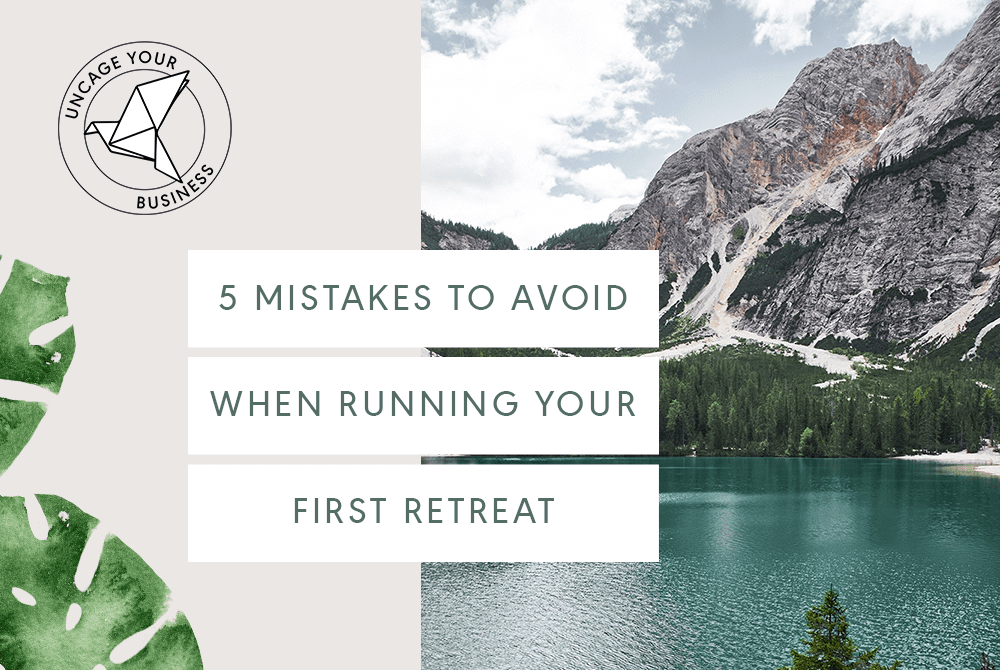
5 Mistakes To Avoid When Running Your First Retreat
If you’re like me, the idea of getting paid to travel is one of the best things you can think of! VERY early on in my business I knew I wanted to run retreats in my coaching business. I mean, my business is called The Uncaged Life – retreats are a super way to stay uncaged while getting paid!
Ever since I ran my first retreat back in 2014, people have been asking me over and over again “How do you run retreats? Teach me!”
me!”
So – here we are!
In fact, I created a whole course about retreats just because so many people asked me to (check the course out here!). I believe in retreats SO much that I don’t want to see people running shitty ones or going broke from them.
Retreats are an awesome way to grow your business – they help you connect with your clients, create deep transformation in the people you work with, help boost your income, and give you a chance to see the real-life impact of your work, especially if most of what you do is online.
It’s amazing to see the changes that can happen in your clients (and yourself!) when you get out of the everyday and into a new environment together. Just magical.
If you want to learn how to run retreats, there are a few pitfalls and mistakes to know about before you dig in. I’ve learned a lot about what works and what doesn’t, and have even interviewed other retreat leaders to learn from their experiences along the way.
The 5 biggest mistakes new retreat leaders make (and how to avoid them)
Mistake #1: Running retreats too soon
This is a tough one, right? Because many people want to run retreats NOW, and I totally encourage going after what you want… AND – often, a new business just isn’t retreat-ready yet.
If you launch too soon, you stand the chance of wasting time, losing money, and hearing crickets. So basically, the opposite of what you’re hoping for.
Everyone always wants to know the magic number for a retreat:
- How big should my list be?
- How many clients should I have worked with?
Surprise, surprise, there is no ONE right answer.
I know people with huge lists who have had trouble selling spots, and people with no lists that were able to fill retreats with their current network.
A good rule of thumb is that if you can think of at least 5 people right now (whether from your client list, your personal network or your email list) who would say YES to this retreat, you’re probably good to go ahead and start planning.
If you have no idea where you’d even promote or who you could get to come, then it’s probably worth your while to hold off on planning and work on growing your network before you do retreats. This can happen quickly – give it 6 months of solid community building and you could be ready to go!
Mistake #2: Not planning in advance
It’s not that the actual retreat planning takes THAT long, it’s that venues fill up fast, so you want to make sure to plan well ahead of time, especially if you’re planning on doing your retreat in the high season.
Planning well in advance also gives you lots of time to market and sell your retreat. If you scramble to plan last minute, that means less nurture time for your people and less likelihood that you will fill your spots.
How far in advance is far enough? Here are my guidelines:
- 4-6 months for a local retreat
- 6-12, months for an international retreat
- Longer is better if you’re not sure!
Mistake #3: Not putting enough emphasis on marketing
I’m not gonna lie – the planning of the retreat is the fun part…but the marketing can suck, especially if you have NO idea how to market a retreat.
Many people think that just creating it and making it amazing will fill it. And in some cases, if you have a primed engaged email list, it can. But in a lot of cases, this is not enough.
You’ll want to make sure you’re marketing your retreat well in advance and marketing it in several different ways.
Email marketing, word of mouth, networking and referrals, Facebook ads, and a combo of other social media methods need to be employed, consistently, until it fills. Sales calls and Q&A calls should also be part of this plan.
I’ve said it before and I’ll say it again planning (once you know what you’re doing) is the easy part. Filling your retreat is often the biggest challenge.
Mistake #4: Paying too much out of pocket
Retreats are only risky if you make them risky!
There are lots of ways to make sure that you don’t lose money, and making sure not to pay ANYTHING out of pocket is one of them!
This often happens if you are planning last minute and need to make hasty decisions, so one more point for planning in advance! You can ask your venue to save the dates for you without having to pay down a deposit, and then you can pre-sell early-bird seats to help you make the money you need to pay the venue. Win!
Make sure to calculate how many people you’ll need to sign on at the early bird rate to be able to make your deposit, and hustle til you get them! If you don’t fill those spots, you can always cancel and wait to build your interest list more before you try again.
Once you do have those deposits, those folks will be on a payment plan and you’ll be able to use their payments to continue making any relevant bookings or payments for your retreat. And then of course, once you open up to the masses and have people rolling in, you’ll be well on your way to profit and won’t have to worry about losing money.
Mistake #5: Packing your retreat schedule too full or too loose
There is a fine balance between how you decide to schedule your retreat:
- Pack it too loosely and people won’t understand why they paid a premium just to go on a vacation they could have booked themselves.
- Pack it too tight, and there will be no breathing room to take everything in and just enjoy.
If you’re doing workshops or teaching on your retreat, it can be overwhelming to teach TOO much, plus, what new retreat leaders often forget is that the discussion is where people get the most value, so leave lots of time and space for discussions what they are learning.
If your retreat is meant to be more fun and less about learning anything specific, it’s important to still have SOME organized group time, and this could be as simple as having a morning check-in with everyone after breakfast and having a variety of group activities to choose from during the day.
In either case, remember that your retreat is meant to be a getaway for people, so make sure your schedule allows for some downtime!
Retreats are a helllll of a fun time, and are also a helllll of a lot of work to plan, market, and fill (and profit). By making sure you don’t make these common mistakes you’re setting yourself up for a successful and less stressful retreat planning experience!

